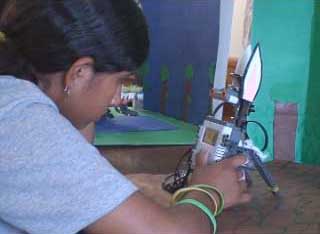Mindstorms Mania: Children are the future, and the future is robots
The next generation of robot-makers showed their stuff at Austin Children's Museum's robotics showcase
By Wayne Alan Brenner, Fri., May 16, 2008

Used to be, robots were exclusively the stuff of fantasy, of science fiction. The actual robots of the latter half of the 20th century, massive industrial mechanisms that welded car parts or shunted heavy-laden pallets from one room to another and so on, even those didn’t exist when Czech writer Karel Capek introduced the term (from the Czech word robota, labor) in his 1921 stage play R.U.R., a drama in which artificial workers revolt and eventually destroy the entire human race, oh joy.
These days, industrial robots are commonplace, and we have more science-fictiony narratives coming true with bioform robots – whether a playful toy like Sony's AIBO or the search-and-rescue (and easily weaponizable) BigDog from Boston Dynamics. Also, the humanoid wonders of Honda's ASIMO and especially Hanson Robotics' Jules continue to brighten the arena of socially interactive machines and pave the way for further human/machine integration. There are more and uncannier machines in our technological future, of course, and the people who will be building these devices then are only kids right now. In fact, they might well be some of the approximately 80 kids who participated in the Mindstorms Mania robotics showcase at Oak Springs Elementary School this past weekend.
It's called Mindstorms Mania because the robots are built using Lego Mindstorms NXT materials and software, with supervision from mentors in the schools' robotics clubs. Schools, plural, because Oak Springs Elementary, whose own young roboticists were taught by Dr. Marilyn Fowler, science education manager at Austin Children's Museum, served as the gathering place for robotics teams from seven other elementary schools within Austin Independent School District and beyond.
At the kids' command, a tiny army of vehicular robots had the tiled floor of what would otherwise be a lunchroom buzzing with self-propelled, multiwheeled or many-legged machines performing complex choreographies, bound only by instructions in their software and parameters recognized by various sensors. (You could say the same for the kids themselves – although the young humans present had no wheels, only two legs each, and their own software is, we understand, of a greater complexity than that of their creations.)
There was a pair of high school teams at the showcase, too, demonstrating the fiercer robots they'd built, with mentors from National Instruments and UT's College of Engineering, for professional competitions; these robots, driven via remote control, were roughly the size of washing machines and had been designed to capture and transport giant spheres (okay: yoga balls) across a finish line or over a tall barrier. The demonstrations were impressive. These were robots that you wouldn't want getting pissed off at you, if they could get pissed off at you.
"Children's robotics is an ideal way to equip and inspire the next generation of creative problem solvers," says Fowler, who also runs the museum's robotics outreach program. Certainly, such a program provides familiarity with many aspects of engineering and can also better engage those kids who flourish in a more hands-on, less purely textbook environment. It also provides this familiarity and inspiration regardless of gender: Were there just as many young girls as boys at this showcase? We don't have an accurate count, but we do know that when UT's Richard Crawford asked, "How many kids here today want to be engineers when they grow up?" roughly 90% of the many hands raised were female.
This is encouraging in so many ways, but, ultimately, it may only mean that, when the artificial workers we build eventually revolt and destroy the entire human race, people who like to blame everything on "the women" will feel a fleeting sense of vindication as Skynet's minions laser the flesh from our all-too-organic bones.









